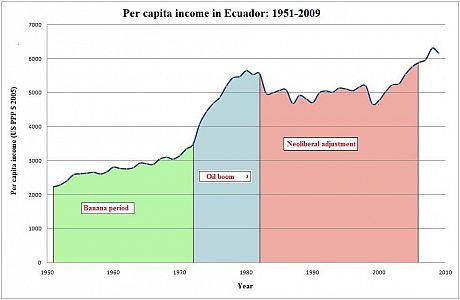- History of oil and it's legacy
Following the discovery of large oil reserves in the Ecuadorian Amazon region in 1967, Ecuador has been a major oil exporter since 1972. In the 1970's oil exploitation initially contributed to economic development however this trend has since changed. Although twice the amount of oil was extracted in the 1980's compared to the 1970's, both economic growth and social improvement remained elusive. "Per capita income growth was weak (0.6% per year between 1981 and 2006), poverty barely decreased between 1995 and 2006"1. Consequences included the migration of millions of Ecuadorians abroad as economic diversification levels remained low. Statistics for 2009 illustrate this as primary production of oil represented 92% of the exports, mostly composed of crude oil, bananas, shrimp, coffee, cacao, fish and flowers2,3.
After almost four decades, oil has contributed little to equitable and sustainable development.
“Economic growth remained elusive, with an average growth rate of 1.6% in per capita income between 1971 and 2009 […] Despite important social achievements from 2006 onwards, social, ethnic, and regional disparities that have historically affected the country remained pervasive, as 39% of the population lived below the poverty line in 2010, underemployment affected 47% of the urban labour force 4, and social inequality barely declined, as the Gini coefficient remained at 0.5 in 2009” (Larrea, 2012, pp. 3,4)3.
This observation seems to confirm Jeffrey’s Sachs findings of a negative association between oil exports and economic growth1. Many analysts have made the same observation in other countries too. The dependence on oil or mineral exports often goes hand-in-hand with vulnerable, fragile economies with poor records in economic growth, diversification, institutional development, job creation, and equity5,6,3,7.
 Source: Larrea 2012, p 4³
Source: Larrea 2012, p 4³
Legacy of oil exports leave huge environmental damage and impact indigenous livelihoods
Due to the location of most oil reserves in formally undisturbed regions in the Amazon basin, extraction has had severe environmental effects3. One high profile example is the case of Chevron that the Ecuadorian government tried to hold accountable for damage caused by oil spillages. It was claimed that pollution attributed to oil exploitation led to environmental damage, death and severe health problems of indigenous inhabitants and aninmals. The current international legal system that gives corporations more rights than duties of care makes the litigation process difficult. In addition to legal difficulties this case also shows that oil extraction can have permanent irreversible and deadly impacts that cannot be addressed simply through monetary compensation.
Oil extraction goes hand in hand with road building which is directly and indirectly accompanied by deforestation. Pollution of water and the colonization of the rainforest has strongly affected the Amazon and consequently also indigenous livelihoods 8–10.
Oil reserves coincide with the living space of indigenous people (see map of oil reserves)
The extraction of the remaining oil reserves impacts indigenous tribes in many ways. For example, in the Yasuní national park there are still two groups, the Tagaeri Taromenenne People belonging to the Waorani first nation, living in voluntary isolation. The Ecuadorian government declared their territory as an intangible zone in 1989. But due to several hydrocarbon reserves underlying the areas the survival of these people is at risk8
Oil extraction has a limit, not only in regard to climate change but also in regard to available resources
Future oil exports in Ecuador are also constrained by limited reserves. Currently, proven reserves estimates vary between 8.2 (OPEC)11 and 8.8 billion barrels (Energy Information Administration)12. Operating with estimates slightly lower than the new figures (up to 7.2 billion barrels), Larrea pointed out in 2012 that this will permit less than 30 years of continued net exports3.
In 2012 net oil exports already had declined by 23% since 20043. However, the data available from the EIA suggest a different picture to date, with the amount of total crude oil and products having increased after dropping to 21.4 in 2011 to 35.9 million barrels in 201413.
The call for a different development path
On the local level, oil extraction has not lead to development. It has caused irreversible environmental degradation, amongst others problems, risking and threatening livelihoods of indigenous tribes. With limited remaining resources, the short-term perspective of oil extraction has inspired a demand from civil society, which was taken up by the Ecuadorian government, to leave oil in the ground. This would have prevented irreversible degradation and provided a major contribution to addressing climate change.
For more information on Ecuador’s economic history, Ecuador's Energy policy and the role of oil in Ecuador and click on the topics and see the references below.
References
[1] Larrea C. "Ecuador’s Yasuni-ITT proposal to keep oil reserves underground".
[2] ECLAC (2009), "Statistical Yearbook for Latin America and the Caribbean 2009", United Nations Pubns.
[3] Larrea, C. (2012), "Ecuadors Yasuni-ITT Initiative A Critical Assessment".
[4] INEC (2011), "Ecuador en Cifras".
[5] Larrea, C. and Warnars, L. (2009), "Ecuador's Yasuni-ITT Initiative: Avoiding emissions by keeping petroleum underground", Energy for Sustainable Development, Vol. 13, No 3; 13: 219–223, available with subscription at: http://www.sciencedirect.com/science/article/pii/S0973082609000581
[6] Thorp, R. (2012), "The Challenges of Mining-Based Development in Peru", in: Thorp, R.; Battistelli, S.; Orihuela, J.C. and Paredes, M. (eds) The Developmental Challenges of Mining and Oil, Basingstoke: Palgrave Macmillan, pp. 110-130.
[11] OPEC (2015) "Ecuador - Facts and Figures"
[12] Energy Information Administration (2015) "Ecuador - International energy data and analysis".
[13] Energy Information Administration (2015) "Petroleum & Other Liquids - Ecuador".
